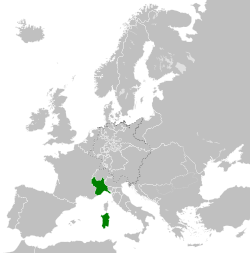Sardinia Piedmont
| Kingdom of Sardinia | ||||||||||||||||||
|
Regnum Sardiniae et Corsicae Reino de Cerdeña Royaume de Sardaigne Regno di Sardegna |
||||||||||||||||||
|
||||||||||||||||||
|
||||||||||||||||||
|
Motto FERT FERT FERT (Savoyard period) |
||||||||||||||||||
|
Kingdom of Sardinia in 1815.
|
||||||||||||||||||
| Capital |
Cagliari (1324–1720, 1798–1814) Turin (1720–1798, 1814–1861) |
|||||||||||||||||
| Languages | Sardinian, Corsican, Catalan and Spanish,Italian (from 1760 onwards), French, Piedmontese, Ligurian | |||||||||||||||||
| Government |
Absolute monarchy (1324–1849) Parliamentary constitutional monarchy (1849–1861) |
|||||||||||||||||
| King | ||||||||||||||||||
| • | 1324–1327 | James II of Aragon (first) | ||||||||||||||||
| • | 1849–1861 | Victor Emmanuel II of Italy (last) | ||||||||||||||||
| Prime Minister | ||||||||||||||||||
| • | 1848 | Cesare Balbo (first) | ||||||||||||||||
| • | 1860–1861 | Camillo Benso (last) | ||||||||||||||||
| Legislature | Parliament | |||||||||||||||||
| • | Upper house | Subalpine Senate | ||||||||||||||||
| • | Lower house | Chamber of Deputies | ||||||||||||||||
| History | ||||||||||||||||||
| • | Papal investiture | 1297 | ||||||||||||||||
| • | Actual establishment | 1324 | ||||||||||||||||
| • | Kingdom to Habsburg | 1714 | ||||||||||||||||
| • | Kingdom to Savoy | 1720 | ||||||||||||||||
| • | Perfect Fusion | 1848 | ||||||||||||||||
| • | Loss of Savoy and Nice | 1860 | ||||||||||||||||
| • | Becomes the new Kingdom of Italy | 1861 | ||||||||||||||||
| Area | ||||||||||||||||||
| • | 1859 | 73,810 km² (28,498 sq mi) | ||||||||||||||||
| Currency |
Cagliarese (to 1813) Sardinian scudo (to 1816) Piedmontese scudo (to 1816) French franc (1800–14) Sardinian lira (1816–61) |
|||||||||||||||||
|
||||||||||||||||||
| Today part of |
|
|||||||||||||||||
The Kingdom of Sardinia was a state in Southern Europe which existed from the early 14th until the mid-19th century. It was the predecessor state of today's Italy.
When it was acquired by the Duke of Savoy in 1720, it was a small state with weak institutions. However, the Savoyards united it with their possessions on the Italian mainland and, by the time of the Crimean War in 1853, had built the resulting kingdom into a strong power. The composite state under the rule of Savoy in this period may be called Savoy-Sardinia or Piedmont-Sardinia, or even the Kingdom of Piedmont to emphasise that the island of Sardinia was of secondary importance to the monarchy. The formal name of the entire Savoyard state was the "States of His Majesty the King of Sardinia". Its final capital was Turin, the capital of Savoy since the Middle Ages.
The kingdom initially consisted of the islands of Corsica and Sardinia, sovereignty over both of which was claimed by the Papacy, which granted them as a fief, the regnum Sardiniae et Corsicae ("kingdom of Sardinia and Corsica"), to King James II of Aragon in 1297. Beginning in 1324, James and his successors conquered the island of Sardinia and established de facto their de jure authority. In 1420 the last competing claim to the island was bought out. After the union of the crowns of Aragon and Castile, Sardinia became a part of the burgeoning Spanish Empire. In 1720 it was ceded by the Habsburg and Bourbon claimants to the Spanish throne to Duke Victor Amadeus II of Savoy. The Kingdom of Sardinia came to be progressively identified with the states ruled by the main branch of the House of Savoy, which included, besides Savoy and Aosta, dynastic possessions since the 11th century, the Principality of Piedmont (a possession built up in the 13th century), and the County of Nice (a possession since 1388). While in theory the traditional capital of the island of Sardinia and seat of its viceroys was Cagliari, the Piedmontese city of Turin was the de facto capital of Savoy.
...
Wikipedia



